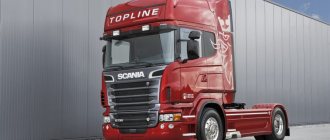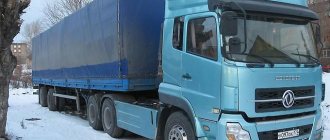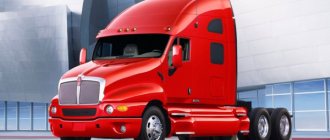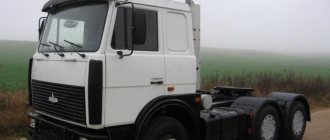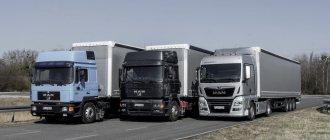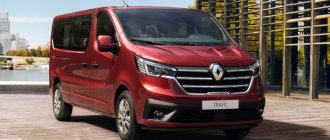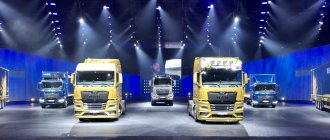Measure of effectiveness
Daniil Minaev, photo by the author
The new generation of Scania Next Gen trucks, first presented in 2022, was initially presented to industry journalists in the guise of a long-haul tractor. Then the XT construction line appeared, then multiple new generation versions of the excellent Swedish brand came to the market.
We were able to test the Scania S500 A4x2NA tractor in Sunny Yellow, not as part of official presentations, but directly during a long Eurasian flight.
A road train loaded with equipment for the baking industry was on an international flight. He left the country of loading - Italy, smoothly rolled out of the European Union and headed east beyond the Urals. The long long journey had to be made on a Scania S500 A4x2NA Sunny Yellow tractor with a 3-axle 27-ton Kögel SN24+ semi-trailer.
Technical minimum from the operator's point of view
Previously, Scania produced 500 “mares” from a V8 engine, but now such power is produced by a conventional 13-liter inline six DC13 155 of the sixth environmental class with an XPI injection system and exhaust gas neutralization using SCR technology using synthetic urea. The power is the same, but the weight and dimensions of the motor are lower. The torque has also increased: 2550 Nm for the new engine versus 2500 Nm for the V8.
Unlike the previous generation, there is no EGR exhaust gas recirculation system, as well as a variable geometry turbocharger. The compression ratio has been increased from 17.6 to 20.0. New injectors and intercooler have reduced fuel consumption.
In winter, at partial loads, the engine oil sometimes did not heat up, internal losses increased and conditions were created for the formation of carbon deposits. The oil cooler oil thermostat is now responsible for controlling and optimizing the engine oil temperature.
The gearbox is a “robot” Opticruise GRS905 without a retarder. But, as practice has shown, for a long-haul road train for international transport in the direction “Central Europe – Ural”, a motor retarder is sufficient. The design of the gearbox now includes an intermediate shaft brake. It is built into the housing of the oil pump, driven from the gearbox input shaft, and is a multi-disc brake mechanism. Its function is to reduce the speed of rotation of the intermediate shaft when shifting up and relieve the synchronizers, which has reduced gear shift time by 45%.
Such a transmission set has a beneficial effect on fuel economy and optimizes dynamic loads on the semi-trailer kingpin, stabilizing the road train during acceleration and braking. As a result, even with a maximum load of 20 tons, the average ground speed increases. For long-distance transportation with a crew of one driver, this is a very significant indicator.
CHASSIS
The truck chassis has been redesigned. The front axle is shifted from the standard position 50 mm closer to the bumper (the front overhang is reduced). On truck tractors this led to an increase in the wheelbase by the same amount. This was done to reduce the degree of forward tilt of the truck in the event of sudden braking (also by shifting the center of gravity of the cab down) and to make the truck more comfortable to drive.
Now the basic equipment of trucks is equipped with 30-inch brake chambers for front axle disc brakes. This further ensures high braking performance regardless of whether braking is applied by the driver or by the AEB system. Real-world braking distances are affected by factors such as tire and road conditions, but all things being equal, the new truck has a braking distance that is 5% shorter.
The new in-line “six” is not much inferior to the V-shaped “eights”. But it has become structurally simpler and more reliable in operation due to the absence of complex units
The design of the frame, suspension and other chassis elements have not undergone any significant changes. In general, they do not seek good from good.
Test in LTL logistics mode
Under the “sunny” hood, the driver has nothing special to do on the road. Unless you add antifreeze, and only if the need for this is indicated by the indication on the instrument panel. The almost complete absence of electrical wiring harnesses looks curious - the Scania S500 4×2 NA is completely at the mercy of the multiplex!
The winter weather in the Volga region was surprising in its variety. In less than a day, snow and rain repeatedly brought black ice onto the highway, but after a hundred kilometers we were greeted by clear weather and dry asphalt, which after an hour of travel turned into slippery ice, visibility dropped to a minimum in a foggy haze, and a side wind whistled threateningly from the fields. This time there will be no classic test drive on public roads.
There is enough space in the cabin for simple accessories: dishes, water bottles and charger cords - i.e. those household items that bring the person in the cabin at least a little closer to a distant home...
General advantages
All three tractor units with a high roof and a flat floor were purchased under the Scania DRIVE program, which involves the purchase of equipment through leasing, as well as included maintenance (service contract), driver training, a fleet monitoring system and insurance in one package . All vehicles are equipped with the new generation Scania FMS vehicle monitoring system with advanced features that include two-way messaging between the driver and the office. The ability to set tasks for the driver in real time can reduce idle runs, and therefore increase vehicle performance.
External lighting devices in all cars - headlights, fog lights, additional high beam headlights and side lights - are LED. They shine better, have a longer lifespan and consume less energy.
The cabin equipment includes an upper berth – 800 mm, a lower sliding berth – 800–1000 mm. There is also parking air conditioning and a refrigerator. The Fiction Blue tractor has a swivel passenger seat, rear storage and TV space.
Morning start
The start from the parking lot is scheduled for 4 o'clock in the morning, there is a light frost outside and snow sparkling in the light of neon street lights. It’s chilly, I really don’t want to once again leave the warm cabin, tightly closed from prying eyes with thick curtains. The engine has not been started for almost 10 hours, but the autonomous liquid heater integrated into the climate control system does its job almost without showing itself. The fan is almost inaudible, but the vigorous starter instantly starts the cold engine.
In automotive technology, progress is not a breakthrough, but optimization of the operation of long-invented and well-known systems, devices and units. A clear example: just a few years ago, liquid autonomous heating was a rather expensive option, requiring constant monitoring and careful handling, but in this brand new Scania, you know, press the buttons, choosing the desired temperature in the cabin... The gray haze of dawn greets us at territory of Chuvashia.
If you keep the speed at about 80 km/h, then the average travel distance, according to the on-board computer, is 62 km/h, the load is 10 tons, the average fuel consumption is 25.9 l/100 km.
Despite the far from ideal asphalt in this mode, the road train is solidly stable, the steering wheel lies within the palm of your hand, practically not asking for any corrective actions, and the new suspension of the front axle of the tractor on parabolic springs in combination with the new air suspension of the cabin with a shock absorber for damping lateral vibrations isolates the crew from road taunts. These circumstances induce drowsiness, which is the most dangerous at the turn of day and night, so we stopped to inspect the truck at the same time. Tires, chassis, awning, lighting, top up with windshield washer - the usual check list for a truck driver. Wipe glass and mirrors? But it’s not required! Another achievement of the new generation of Scania: numerous hours of testing and development work in the wind tunnel made it possible to avoid dirt getting on the side windows and mirrors. To make sure of this, I took photographs through different sections of the path.
LIVE
The road trains chosen for testing were Scania S580 (4×2) with a 3-axle Schmitz Cargobull semi-trailer with a total coupling weight of 36 tons and a Scania R450 (6x2/2) with an unusual 4-axle tank from LAG with a total coupling weight of 40 tons.
In all this there was the following reason: to compare cabins with a flat floor and with a motor tunnel, the traction capabilities of the “six” and “eight”, while not forgetting that regional roads in Sweden are narrower than in Russia.
In essence, nothing special happened in my mind when I first saw the new Scania interior. Everything is thought out to the smallest detail, is within reach, and the number of adjustments is more than enough. No wonder the press release stated that any driver with a height of 150 to 200 cm will be able to find a comfortable driving position. The only thing that caused confusion was the location of the headlight mode switch on the door armrest.
But what, so to speak, pleasure did I experience driving a road train on a specially selected route of 38 km, most of which ran along a road replete with turns, descents and ascents! Everything was at a high level - the truck’s traction capabilities, its braking performance, including the operation of the engine brake, and even adaptive cruise control.
What can you say if so much time and money was spent on developing a car that claims to be in the top segment. At least not in vain.
Day convoy
Scania is loved by drivers for its spacious cabin and excellent visibility thanks to the vertical A-pillars. The ratio of the adjustments of the driver's seat and the steering column allows you to literally play role-playing games of classic types of driver's seating: a passenger car (low seat, almost vertical steering wheel), a bus driver (high seat, horizontal steering wheel at the bottom), a retro truck driver (seat close to the steering column , vertical steering wheel from below), and so on.
The instrument panel keys are divided into functional zones, and the instruments are easy to read. The steering column turn signal lever has an additional non-fixed position: with a slight swing, the signal is briefly turned on for five flashes. The central light switch has moved to the door card on the driver's left hand. With it in a single block there are keys for fog lights, adjustment and heating of mirrors, service lighting of the coupling station and adjustment of the brightness of instrument lighting. The main mirrors, curb mirror, and front bumper viewing mirror received electric drive.
There were no complaints about the Kögel SN24 plus side curtain semi-trailer during loading or on the road. Three-axle axle unit SAF –INTRADISC plus Integral with disc brakes and tridem on a single-pitch Continental HTR2 tire with a dimension of 385/65 R 22.5. The capacity of a 14-meter trailer is 91 cubic meters, its own weight is 6441 kg. Taking into account our load, the road train weighed a total of 25.4 tons. The awning with a movable translucent roof is made of high-strength PVC material with a density of 680 g/m2 and is equipped with a customs lock.
Not like the current tribe...
Tachograph, hydraulic booster, pneumatic-hydraulic clutch, turbocharger with charge air cooler - too much, no, how can all this be in an ordinary five-ton modest truck, and not in a long-haul tractor, and even back in 1968...
Externally, the outlines of the five-ton flatbed truck resemble the shapes of compatriots of that time - ZIL-130 or GAZ-52. At that time, the production of these mass-produced trucks was gaining momentum, and the Scania Vabis L36 remained on the assembly line for about another year, and in 1969 the model was replaced by a cabover vehicle - one of the first in Europe in the class of trucks.
The driving position is dictated by the layout of the cabin, and is also very similar to our “zilka” and “lawn” cars. The elbows are strongly bent, the fifth point rests on the soft cushion of a blown sofa, and, naturally, the non-adjustable steering column is crowned with a thin steering wheel of huge diameter. Through the three spokes of a smart white color, simple instruments are visible, but there is not so little information. On the left is an instrument cluster very similar to our Soviet trucks and buses, consisting of a set of scales and indicator lamps. In the center there is a pressure gauge for the pneumatic system, on the periphery there is temperature and oil pressure, and a fuel level indicator. In the center of the dashboard is an engine temperature indicator, on the right is a speedometer combined with a mechanical tachograph. Most likely, the tachograph appeared here later, in the seventies, when it became a legal requirement, and the car had to be retrofitted, but initially there may have just been a speedometer.
Truck stop in the parking lot
The short December daylight has flown by unnoticed and we are leaving Kazan behind us; the 4-lane highway has been replaced by a “two-line highway” with signs of finishing reconstruction and hope for expansion.
It got dark. According to the AETR regulations, the crew is scheduled to rest and must turn to the parking lot. Behind are European highways, Moscow's busy Moscow Ring Road, a tedious bypass of Nizhny Novgorod, Chuvashia with its funny names of settlements for a Russian person (Signal-Kotyaki, Bolshie Karachury, Moskakasy), Tatar meadows and hilly landscapes of the surroundings of the Sviyaga River. Ahead is the crossing of the Ural Mountains and unloading in Chelyabinsk. At the end of the test drive, the odometer of the Scania S500 A 4×2 NA showed just over 40,000 km. The service interval for Russia is 60,000 km. Most likely, the first maintenance in a couple of tens of thousands of miles will take place under the banner of replacing consumables and scheduled checks.
Technical characteristics of Scania S500 A4x2NA (S4X20-type)
| Curb weight of the tractor/total weight of the tractor with load on the saddle, kg | 8798/ 19 000 |
| Gross weight of the road train, kg | 40 000 |
| Permissible load on 1st and 2nd axles of the tractor, kg | 7500/ 11 500 |
Engine:
| Scania DC 13 155, turbodiesel, I-6, Euro 6 12 742 500 at 1900 rpm 2550 at 1000–1300 rpm |
Transmission
| Scania GRS905 Opticruise Automated 10/ 1 |
| Main gear ratio | 2,92 |
| Suspension | Front on parabolic springs, rear – pneumatic double-balloon |
| Brake system | Pneumatic |
| Wheel formula | 4x2 |
| Tire size | 315/70R22.5 |
| Fuel tank capacity, l | 750+620 (1370) |
| AdBlue tank capacity, l | 80 |
| Battery capacity, total, Ah | 230 |
| Maximum speed, km/h | 89 |
